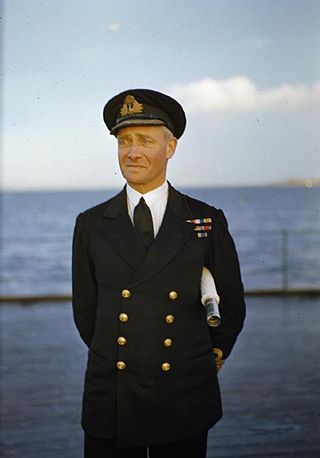
The Commander-in-Chief, The Nore, was an operational commander of the Royal Navy. His subordinate units, establishments, and staff were sometimes informally known as the Nore Station or Nore Command. The Nore is a sandbank at the mouth of the Thames Estuary and River Medway. In due course the Commander-in-Chief became responsible for sub-commands at Chatham, London, Sheerness, Harwich and the Humber.

Rear Admiral Philip John Mack DSO* was an officer of the British Royal Navy.

The Commander-in-Chief, Portsmouth, was a senior commander of the Royal Navy for hundreds of years. The commanders-in-chief were based at premises in High Street, Portsmouth from the 1790s until the end of Sir Thomas Williams's tenure, his successor, Sir Philip Durham, being the first to move into Admiralty House at the Royal Navy Dockyard, where subsequent holders of the office were based until 1969. Prior to World War I the officer holder was sometimes referred to in official dispatches as the Commander-in-Chief, Spithead.

The Assistant Chief of the Naval Staff (A.C.N.S.) is a senior appointment in the Royal Navy usually a two-star rank and has a NATO ranking code of OF-7.

The Operations Division was a former directorate of the Admiralty Naval Staff responsible for the creation and implementation of long-term policy in regards to the composition of all Royal Navy fleets, squadrons and commands and including operational planning and monitoring from 1912 to 1961.

The Naval Mobilisation Department also known as the Mobilisation and Movements Department was a former department of the British Admiralty initially from 1909 to 1912 and then again from 1918 to 1932. It was mainly responsible for plans, mobilisation and manning during the pre-World War I and post war period.

The Mobilisation Division was the former Directorate of the British Admiralty Naval Staff responsible for mobilisation requirements, manning and war preparation planning from 1912–1918.

The Gunnery and Torpedo Division was the former Directorate of the Admiralty Naval Staff responsible for weapons policy making, development and assessing weapon requirements from 1918-1920.

The Air Division originally known as the Air Section and later known as the Naval Air Division was first established in 1924 and it was a Directorate of the Admiralty Naval Staff, that was initially responsible for operational control of aircraft supplied to the Royal Navy by the Air Ministry. In 1939 it was gained full control for the all matters relating to administration, control, policy and organisation of the Fleet Air Arm, it underwent various name changes until it was absorbed as part of the merger of the Admiralty into the new Ministry of Defence in April 1964 as part of the Navy Department where it continued until May 1966 when its remit was changed and when became the Directorate of Naval Warfare.

The Signal Division was a Directorate of the Admiralty Naval Staff responsible for policy, control and management of all naval communications from 1914 to 1964.

The Naval Ordnance Department, also known as the Department of the Director of Naval Ordnance, was a former department of the Admiralty responsible for the procurement of naval ordnance of the Royal Navy. The department was managed by a Director, supported by various assistants and deputies; it existed from 1891 to 1958.

The Department of the Director of Naval Equipment also known as the Directorate of Naval Equipment was the former British Admiralty department responsible for managing the progress of all naval construction at royal naval dockyards, and annually planning programmes of works for additions, alterations, repairs and modernisation established in 1912 until 1960 when it was replaced by the Naval Equipment Division of the Ship Department.

The Trade Division was a Directorate of the British Admiralty, Naval Staff responsible for all matters in relation to U.K. Trade Defence from 1914 until 1928 and then again from 1939 to 1961.

The Gunnery Division was a Directorate of the Admiralty Naval Staff of the Royal Navy responsible for the tactical use of naval weapons and the training of naval personnel in relation to operational requirements. It was established in 1920 when the Gunnery and Torpedo Division was separated into an independent Gunnery Division and Torpedo Division. It existed until 1964 when the Department of Admiralty was abolished and replaced by a new Ministry of Defence.

The Training and Staff Duties Division and later known as the Tactical and Staff Duties Division was a directorate of the Admiralty Naval Staff of the Royal Navy responsible for the tactical use of naval weapons and the training of naval personnel in relation to operational requirements from 1917 to 1958.

The Admiral Commanding, Reserves, was a senior Royal Navy post that existed from 1875 to 1976.

The Red Sea Station was a military formation of the Royal Navy. At various times it has also been referred to as Egypt Division and Red Sea and later the Red Sea and Canal Area. The Royal Navy had distinct formations for the Red Sea at intervals from 1846 until circa 1944-45.

The Directorate of Navigation and Tactical Control (Naval) was a directorate of the Navy Department, Naval Staff first established in 1912, as the Navigation Department of Hydrographic Department of the Admiralty. In 1945, it was renamed the Navigation Division and assigned to the Admiralty Naval Staff. In 1946, it was redesignated Navigation and Direction Division until 1966, and now part of the Navy Department Naval Staff it was renamed the Directorate of Navigation and Tactical Control (Naval). The staff directorate was administered by the Director Navigation Tactical Control (Naval) who reported to the Assistant Chief of the Naval Staff (Warfare) it existed until 1968.

The Department of the Director of Underwater Weapons Materials originally known as the Torpedo Department was a former department of the British Department of Admiralty from 1917 to 1958 when it became the Underwater Weapons Division of the Weapons Department.





